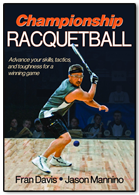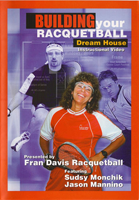 With The National Doubles Championships coming up in February 2016 I thought it would be apropos to cover some doubles shot selection. Shot selection is no different for doubles than for singles; you use the formula A (You) + B (Ball) + C (Opponent) + D (Score) = E (Shot Selection-choice of shot). Just remember there are two extra people on the court. Therefore your choice of shots needs to be smarter and more precise because you have to get the ball past two players instead of one, and you do not want to hit your partner. This makes doubles less forgiving—you have less room for errors compared to singles.
With The National Doubles Championships coming up in February 2016 I thought it would be apropos to cover some doubles shot selection. Shot selection is no different for doubles than for singles; you use the formula A (You) + B (Ball) + C (Opponent) + D (Score) = E (Shot Selection-choice of shot). Just remember there are two extra people on the court. Therefore your choice of shots needs to be smarter and more precise because you have to get the ball past two players instead of one, and you do not want to hit your partner. This makes doubles less forgiving—you have less room for errors compared to singles.
The pass shot is critical in doubles because it moves your opponents out of the middle and into the backcourt. This gives you and your partner a chance to get into better court position and forces your opponents to shoot around both of you. The down-the-line pass is great when playing a front/back team because down the line is the farthest shot for them to have to reach. You also want to use it against two righties or two lefties because one player must cover the backhand side, which is usually weaker. The wide-angle pass is also a good shot when playing against two righties or two lefties because the backhand player doesn’t have the correct angle to hit the ball effectively or hit it at all.
The jam pass is a variation of a wide-angle pass, but instead of hitting the sidewall between the short line and the dotted line, you hit the sidewall on a fly, closer to the front wall so the ball goes into the middle of the court. This is one of the best shots against a lefty/righty team because it goes to both players’ backhands. The pass down the middle is a variation of the pass down the line and does exactly what the name depicts, goes down the middle; this shot is used against a lefty/righty team because it goes to both players’ backhands and handcuffs them.
The reverse pinch is sometimes useful in the frontcourt when your opponent is behind you because you can block them out with your body, both visually and physically. A right-handed player will hit the ball from the right side of the court and hit the reverse pinch into the left corner. A left-handed player will hit the ball from the left side of the court and hit the reverse pinch into the right corner. That is a tough shot for your opponent to see and move up to get.
The Z shot or a ceiling ball are great when you do not have an offensive shot and must go defensive, as it pulls your opponents to the backcourt. When the opportunity presents itself to hit a Z or a ceiling ball, the Z shot is more effective because the ball hits three walls consecutively and comes off the second sidewall with natural spin and speed. This makes it more difficult to return than just a ceiling ball. And the fact that there are two more players on the court in doubles than in singles makes it a frustrating shot for your opponents to return.
Like the wide-angle pass, the Z creates confusion because the two players will be going after the ball at the same time since it goes through both sides of the court before landing.
Use the Playing Doubles chapter in my book, “Championship Racquetball”to understand doubles shot selection in detail. This will lead to putting more pressure on the doubles team you are playing, Chapter 11 (pages 267-268 & 272).
I use “The Art of Doubles Shot Selection” with my “Championship Team,” Rocky, Paola, Jason, Jordan, Wayne and Mitchell, as at one point or another they all play or have played doubles. I encourage each and every one of them to use solid “doubles shot selection” to play at their highest levels of doubles play. Here are some of the BEST doubles teams that have won numerous amateur & pro national and world championship titles using the above information on doubles shot selection:
Jason Mannino/Sudsy Monchik
Jason Mannino/Cliff Swain
Jason Mannino/Kane Waselenchuk
Rocky Carson/Jack Huczek
Rocky Carson/Jose Rojas
Paola Longoria/Samantha Salas
Paola Longoria/Veronica Sotomayer
Jordan Cooperrider/Erika Manilla
Wayne Antone/Kevin Vasquez
Mitchell Turner/Julian Singh
ALL of the players I coach, from the professionals led by Rocky and Paola to the amateurs, know just how important it is to learn “The Art of Doubles Shot Selection” and it starts with understanding the shots to take in given situations. Their doubles records speak for themselves…Rocky is the 2014 National Doubles Champion and Paola is the 2014 & 2015 National Doubles Champion for their respective countries. They have BOTH competed at numerous World Championships and Pan American Championships.
In the next issue, I will continue to build your Championship Racquetball Game one level at a time so you too can be ready to become the champion you always dreamed of becoming, by giving you the tools to make it a reality. Rocky’s and all my athletes “Championship Racquetball Games” stem from their focus on ALL three sides of the triangle working together so they can develop into top competitors. Without a shadow of a doubt, they KNOW just how important it is to do the work. They are living proof it works and their titles substantiate it.
For details on more personalized instruction, a weekend camp, instructional DVD’s and our book, (Championship Racquetball) ALL which covers all aspects of the Sports Racquetball Triangle and more, please visit www.FranDavisRacquetball.com Fran Davis is a 2004 racquetball Hall of Fame inductee; Racquetball Woman of the Year 2009; Coach #2 International Racquetball Tour ( IRT ) Pro Player / 1X US Open Champion / 4X and present World Champion, 2X Pan American Champion, Rocky Carson; Coach #1 Women’s LPRT Pro Player / 6X and present US Open Champion & 4X World Champion, 2X Pan American Champion, Paola Longoria; Coach Jr. World & National Champion, Jordan Cooperrider, Wayne Antone & Mitchell Turner; Master Professional Instructor/Coach USAR-IP.










